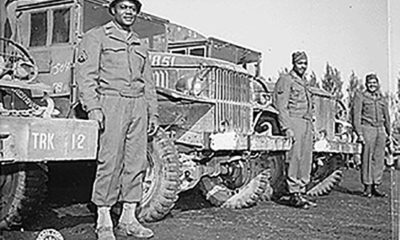Culture
The Arkansas-born Legend of the Wild West

Bass Reeves (1838–1910)
Bass Reeves was the greatest frontier hero in in American history. He walked into the valley of death every day for thirty-two years. He dedication to duty was beyond reproach, on one occasion he arrested one of his own sons for murder. On another occasion he arrested the minister that baptized him for breaking a law. It is estimated that Reeves arrested more than three thousand men and women who broke federal law in the Indian and Oklahoma Territories. The residents of the territories was singing songs about him during his lifetime. One of the territorial settlers said that Reeves was so tough, he could spit on a brick and it would break. If a felon tried to run from Reeves, he would get caught. If a felon tried to hide from Reeves, he would be found. If a felon tried to shoot it out with Reeves, it was like committing suicide. Over the thirty years Reeves worked as a federal lawman, some newspapers reported that he killed more than twenty men in the line of duty.
Arkansas native Bass Reeves was one of the first black [1] lawmen west of the Mississippi River [2]. As one of the most respected lawmen working in Indian Territory, he achieved legendary status for the number of criminals he captured. Bass Reeves was born a slave [3] in Crawford County [4] in July 1838. His owners, the William S. Reeves family, moved to Grayson County, Texas, in 1846. During the Civil War [5], Bass became a fugitive slave and found refuge in Indian Territory (modern-day Oklahoma) amongst the Creek and Seminole Indians. Reeves is believed to have served with the irregular or regular Union Indians that fought in Indian Territory during the Civil War.
After the Civil War, Reeves settled in Van Buren (Crawford County) [6] with his wife, Jennie, and children. Oral history states that Reeves served as a scout and guide for deputy U.S. marshals [7] going into Indian Territory on business for the Van Buren federal court. In 1875, Judge Isaac C. Parker [8] became the federal judge for the Western District of Arkansas [9], which had jurisdiction over Indian Territory. This court had moved to Fort Smith (Sebastian County) [10]. In 1875, Reeves was hired as a commissioned deputy U.S. marshal, making him one of the first black federal lawmen west of the Mississippi River.
During his law enforcement career, Reeves stood 6’2″ and weighed 180 pounds. He could shoot a pistol or rifle accurately with his right or left hand; settlers said Reeves could whip any two men with his bare hands. Reeves became a legend during his lifetime for his ability to catch criminals under trying circumstances. He brought fugitives by the dozen into the Fort Smith federal jail. Reeves said the largest number of outlaws he ever caught at one time was nineteen horse thieves he captured near Fort Sill, Oklahoma. The noted female outlaw [11]Belle Starr [11] turned herself in at Fort Smith when she found out Reeves had the warrant for her arrest.
In 1887, Reeves was tried for murder for the shooting of his trail cook, but he was found innocent. In 1890, Reeves arrested the notorious Seminole outlaw Greenleaf, who had been on the run for eighteen years without capture and had murdered seven people. The same year, Reeves went after the famous Cherokee outlaw Ned Christie. Reeves and his posse burned Christie’s cabin, but he eluded capture.
In 1893, Reeves was transferred to the East Texas federal court at Paris, Texas. He was stationed at Calvin in the Choctaw Nation and took his prisoners to the federal commissioner at Pauls Valley in the Chickasaw Nation. While working for the Paris court, Reeves broke up the Tom Story gang of horse thieves that operated in the Red River valley.
In 1897, Reeves was transferred to the Muskogee federal court in Indian Territory. Reeves remarried in 1900 to Winnie Sumter; his first wife had died in Fort Smith in 1896. In 1902, Reeves arrested his own son, Bennie, for domestic murder in Muskogee. Bennie was convicted and sent to the federal prison in Leavenworth, Kansas.
Reeves worked until Oklahoma achieved statehood in 1907, at which time he became a city policeman for Muskogee. He died of Bright’s disease on January 12, 1910. On May 26, 2012, a bronze statue depicting Reeves on a horse riding west was dedicated in Fort Smith’s Pendergraft Park. The statue, which was designed by sculptor Harold T. Holden and cost more than $300,000, was paid for by donations to the Bass Reeves Legacy Initiative.
Editor’s Note: The Bass Reeves statue in Fort Smith, Arkansas stands about 20 feet tall and honors the former slave who became one of the most feared law officials in the region. Professor and historian, Art Burton, is credited with sharing Reeves’ historic significance to a wider audience.
For additional information:
Burton, Art. _Black Gun, Silver Star: The Life and Legend of Frontier Marshal Bass Reeves_. Lincoln: University of Nebraska Press, 2006. ———. _Black, Red and Deadly: Black and Indian Gunfighters of the Indian Territory, 1875–1907_. Austin, TX: Eakin Press, 1991.

-

 Featured10 months ago
Featured10 months agoCalifornia Is the First State to Create A Public Alert for Missing Black Youth
-

 Featured9 months ago
Featured9 months agoAfrican American Leaders Stay the Course Amid Calls for President Biden To Bow Out of Race
-

 Featured10 months ago
Featured10 months agoThe Debate Fallout Lands on Both Candidates
-

 Featured9 months ago
Featured9 months agoPresident Joe Biden Decides to Withdraw from the Presidential Race
-

 Featured9 months ago
Featured9 months agoIn One of His Final Speeches as President, Biden Says It’s Time for ‘Fresh Voices’
-

 Featured9 months ago
Featured9 months agoPresident Joe Biden Describes Shooting of Donald Trump As ‘Sick’









